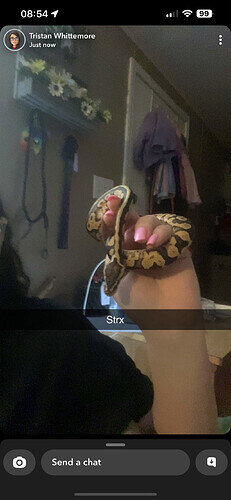Back in the day (2001-ish), when I was super active in ball pythons, I would read over and over about how picky ball pythons were, and how they’d often go off feed. I fed frozen-thawed meals exclusively, even to the animals that were sold to me as “live only” feeders, and I had never had one that was a problem eater. I came to realize that as silly as it sounds, ball pythons, and probably most animals, are a lot like us humans. They need to feel safe. Otherwise, they’ll experience and show signs of stress, such as not eating.
To illustrate, I had a Kingsnake.com forum friend named Michael who was new to ball pythons. He sank a ton of money into a few animals. (Remember when an Orange Ghost male was $3000? LOL He had one as well as a few equally expensive hets.) The male Orange Ghost was a hatchling that he’d purchased a couple months prior, and he simply could not get the thing to eat a single meal. Ever. I explained to Michael how snakes need to feel 100% safe (not 80% or 90%) or they become stressed. I told him to send me his animal, and I’d get it eating. On it’s 3rd day with me, it ate a full meal. Then 2x a week for the next 2 weeks. Like clockwork. Michael came to visit (from NJ to SC) to see how I was doing it.
I employ a very simple formula.
Appropriate size enclosure (length + width = length of snake).
Ten degree heat gradient (82° cool end / front to 92° warm end / back).
Appropriate humidity level of ~65%. (PRO TIP: Adjusting the humidity level up and down is simple. Just use different sized water bowls. Larger water bowls have a greater surface area which aids in more evaporation, which, in turn, increases the humidity level. Smaller bowls will lower the humidity level. For even more fine-tuning, you can place water bowls closer or farther from the heat source. Simple solution that you can use to make each drawer in your rack an individual perfect humidity for whatever snake may be in there.)
Multiple hides, where possible. One hide as a minimum. (PRO TIP: Ball pythons like snug burrows with a single entrance. They should feel the sides and top against their scales. Terra cotta flower pot bases flipped upside-down and hit sharply on the edge with a hammer to create a broken entrance hole always work wonderfully, even with the small top hole. These hides cost about $1 each, and they help to hold and maintain humidity too. Another great but cheap hide is a large flat piece of cardboard with one edge bent down slightly to show the animal that there is a small space under the cardboard. The snake will “burrow” under the cardboard and make it his hide. I tried this once with a ball python that was always burrowing under his newspaper. It dawned on me that he preferred to feel the hide on his back, pressing downward. So I tried a flat piece of cardboard as an experiment, and he never burrowed under the newspaper again. Feeling the hide weigh down upon it’s back is the key.
Frozen-thawed is my preferred feeding method. Mostly for the sake of the snakes. (I always feel sad when I’m browsing the classifieds and I see an otherwise beautiful snake with rodent bite marks on his neck and back.) As everyone else has said, make sure those rodents are fully thawed before warming. There shouldn’t be any hard spots. Oh, and don’t worry about them not striking off tongs. Many of my ball pythons were shy eaters. Just lay it in the tub, slide the tub back in the rack, and check back a few hours later. The rodent is often vanished, and the snake is a bit chubbier than it was a short while ago. 
Please forgive my ramble.
Regards,
Chris

